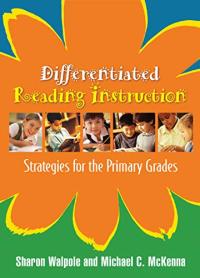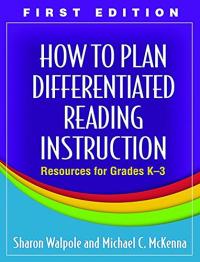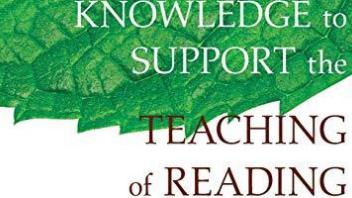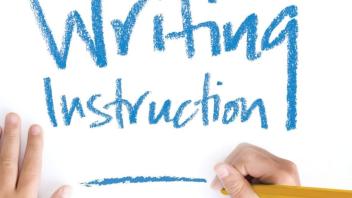Featured booklists
Themed Booklist
Teaching Reading
Themed Booklist
The Cognitive Science of Reading
Themed Booklist
Reading Motivation and Reading Aloud
Themed Booklist
Teaching Writing
Themed Booklist
Learning Differences
Themed Booklist
In the Classroom: Teaching Children on the Autism Spectrum
Themed Booklist
About Autism: Books for Parents and Educators
Adult Education Books

In this updated edition of the ASCD best-seller, Fisher and Frey dig deeper into the hows and whys of the gradual release of responsibility instructional framework. To gradually release responsibility is to equip students with what they need to be engaged and self-directed learners. On a day-to-day level, it means delivering lessons purposefully planned to incorporate four essential and interrelated instructional phases: (1) Focused Instruction: Preparing students for learning by establishing lesson purpose, modeling strategies and skills, thinking aloud, and noticing how students respond; (2) Guided Instruction: Strategically using prompts, cues, and questions to lead students to new understanding; (3) Collaborative Learning: Allowing students to consolidate their understanding through exploration, problem-solving, discussion, and thinking with their peers; and (4) Independent Learning: Requiring students to use the skills and knowledge they’ve acquired to create authentic products and ask new questions.
Better Learning Through Structured Teaching (Second Edition)

A must-have guide for any parent or teacher of a child struggling to learn to read, this essential resource begins by answering the question “What is Dyslexia?” The authors have masterfully selected and distilled the most significant research in the field to provide clear and detailed explanations of the : (1) widely accepted research-based definition of dyslexia; (2) identification and treatment of dyslexia at various stages of development; (3) emotional consequences of reading difficulties; (4) current research on the role of genetics and the brain; (5) essential elements of effective reading instruction; and (6) treatment options for the most severe cases of dyslexia and other reading problems.
Basic Facts About Dyslexia & Other Reading Problems

Creative nonfiction — prose that fuses the conventions of reportage with the aesthetics of literature and the passion for self-expression — is emerging as one of the most important contemporary genres, one that captures the imagination and commitment of student writers. Creating Nonfiction provides everything students need to begin to understand and write creative nonfiction: an engaging rhetoric, an unsurpassed anthology, and a wealth of editorial features that inspire writing.
Creating Nonfiction

In this comprehensive guide, the authors explore the relationship between text, learner, and learning through discussion and rhetorical writing at the elementary, middle, and high school levels. Prompt students to become the sophisticated readers, writers, and thinkers they need to be to achieve higher learning. Clearly defined strategies will drive discussion-based learning. Examine the hidden dangers of controlling classroom discourse, foster critical literacy through questioning and instructional routines, and encourage students to find meaning and cultivate thinking from expository texts, even the most challenging ones. Finally, because all students learn differently, you’ll explore new-media texts and the Web to accommodate learning differences among your students.
Teaching Students to Read Like Detectives: Comprehending, Analyzing, and Discussing Text

In clear and accessible language, Fisher and Frey explain that efforts to improve teaching only work when we see our classrooms as systems: every person and process impacts all the others, and seemingly small changes can have large effects on learning. This book is full of practical suggestions and tools that empower teachers to design the whole system including peer and student-teacher relationships, learning and assessment tasks, and classroom routines to lead to better learning. Identify strategies and tools to create clear learning targets, prepare effective lessons, and successfully assess instruction.
Unstoppable Learning: Seven Essential Elements to Unleash Student Potential

Fisher and Frey set the record straight about text-dependent questions. They demonstrate that text-dependent questions can address not only literal understanding but also understandings about what the text doesn’t say, how the text works, what the text means to and for the reader, how the text might be read in a specific discipline, and more. With specific prompts and concrete examples, Fisher and Frey show us how to use questioning as a central tool to address the Common Core State Standards.
Text-Dependent Questions, Grades K-5: Pathways to Close and Critical Reading

Learn new ways to help middle and high school students develop the habits necessary to read closely, take good notes, then analyze what they have read from multiple sources and synthesize information into effective discussion and, ultimately, solid writing.
Close Reading and Writing From Sources

What it really means to “read closely.” Call it close reading, call it deep reading, call it analytic reading — call it what you like. The point is, it’s a level of understanding that students of any age can achieve with the right kind of instruction. In Rigorous Reading, Fisher and Frey articulate an instructional plan so clearly, and so squarely built on research, that teachers, schools, and districts need look no further. Also included are illustrative classroom video and an online Facilitator’s Guide.
Rigorous Reading: 5 Access Points for Comprehending Complex Texts

Explore strategies for integrating the Common Core State Standards for English language arts for grades K-2 in this interdisciplinary resource, which focuses on areas of instruction, curriculum, assessment, and intervention. You’ll also learn how to implement the CCSS within the powerful PLC at Work process. Critical chapter-opening questions guide discussion and help you leverage the CCSS to optimize student learning.
Common Core English Language Arts in a PLC at Work, Grades K-2

Explore strategies for integrating the Common Core State Standards for English language arts for grades 3-5 in this interdisciplinary resource, which focuses on areas of instruction, curriculum, assessment, and intervention. You’ll also learn how to implement the CCSS within the powerful PLC at Work process. Critical chapter-opening questions guide discussion and help you leverage the CCSS to optimize student learning.
Common Core English Language Arts in a PLC at Work, Grades 3-5

This handbook provides both composition students and instructors with the support they need to be successful. It provides the most balanced coverage of the writing process, grammar, research, and topics important to today’s students. Both respected teachers and authors, Troyka and Hesse give practical advice to students about the writing they will do in composition courses, in other classes, and in the world beyond. Offering instructors a full range of choices in handbooks, the Troyka/Hesse family of handbooks is available in a variety of formats, including Web-based and customized options, so instructors can select the handbook that best fits their course needs. The handbook is also accompanied by MyWritingLab, a valuable online tool featuring an online composing space, interactive eBook, integrated learning resources, and tutoring services.
Simon & Schuster Handbook for Writers (10th Edition)

Again and again the Common Core Standards state that students must read “proficiently and independently” but how do we achieve this when students are groaning about having to read demanding literature and looking for ways to pass the class without turning pages? The author shows middle and high school teachers how to create English classrooms where students care about living literate lives and develop into proficient independent readers. The book includes YA lit pairings with classic texts to aid comprehension, tips to motivate reluctant readers with immersion, encouragement, and small steps, and a study guide and guidelines for curriculum development.
With Rigor for All: Meeting Common Core Standards for Reading Literature (Second Edition)

Words Their Way with PreK-K is a hands-on, developmentally-driven approach to word study that illustrates how to integrate and teach phonics, vocabulary, and spelling skills to the youngest readers. Why word study with PreK and kindergarten students? Because the hands-on approach motivates them, keeps them engaged, and helps them built literacy skills. The word study approach as outlined by renowned Words Their Way authors is a developmentally-driven instructional method. It has always been extremely popular for this developmental approach, as well as its concrete methods for teaching children phonics, vocabulary, and spelling skills.
Words Their Way: Word Study for Pre-K-K

This bestselling book provides indispensable tools and strategies for explicit, systematic phonics instruction in K-3. Teachers learn effective ways to build students’ decoding skills by teaching letter-sound relationships, blending, word building, multisyllabic decoding, fluency, and more. The volume is packed with engaging classroom activities, many specific examples, and research-based explanations. It offers a complete phonics assessment and clear guidelines for sequencing instruction to give every student a strong foundation for reading. More than 30 reproducible forms and word lists are included in the appendices and a wealth of supplemental teaching resources can be accessed online.
Making Sense of Phonics: The Hows and Whys (Second Edition)

Grasping the meaning of a text enables K-8 students to appreciate its language and structure through close reading, which in turn leads to deeper comprehension. This book explains the relationship between comprehension and close reading and offers step-by-step guidelines for teaching both of these key elements of literacy. Reproducible lessons are shared for eight engaging texts (excerpts from fiction, nonfiction, and poetry), complete with discussion tips, queries that scaffold comprehension, close reading activities, and connections to the Common Core State Standards (CCSS). The authors model lesson development and guide teachers in constructing their own lessons. Texts for 10 additional lessons are provided in the Appendix.
Illuminating Comprehension and Close Reading

In this fully revised and expanded edition of a classic, Beck and McKeown share their new findings on Questioning the Author, the approach that galvanized the research field to look at comprehension instruction in a new way. “What’s the big idea?” “What is the author telling us now?” “That’s what the author says, but what does the author mean?” By using queries such as these during reading, at strategic points in a text, students learn how to build meaning and consider and converse with an author’s ideas. These queries help focus discussions on important understandings. They also embolden struggling readers to work through the ideas in a text rather than skim over them. The book includes how-to’s on planning and orchestrating the Questioning the Author approach as well as a practical trouble-shooting guide based on classroom transcripts of 25 common challenges to discussion. For use with Grades 3–8.
Improving Comprehension with Questioning the Author

Responding to readers’ success stories, practical questions, and requests for extended examples, this volume builds on the groundbreaking work of Bringing Words to Life. The authors present additional tools, tips, and detailed explanations of such questions as which words to teach, when and how to teach them, and how to adapt instruction for English language learners. They provide specific instructional sequences, including assessments, for grades K-2, 3-5, 6-8, and 9-12, as well as interactive lesson planning resources. Invaluable appendices feature engaging classroom activities and a comprehensive list of children’s books and stories with suggested vocabulary for study.
Creating Robust Vocabulary: Frequently Asked Questions and Extended Examples

Malik Goes to School synthesizes a decade of research by the authors, Holly Craig and Julie Washington, on the oral language and literacy skills of African American children from preschool to fifth grade. Their research has characterized significant influences on the child’s use of African American English (AAE) and the relationship between AAE and aspects of literacy acquisition. The research has also led to the characterization of other nondialectal aspects of language development. The outcome has been a culture-fair, child-centered language evaluation protocol.
Malik Goes to School: Examining the Language Skills of African American Students from Preschool-5th Grade

When the goal is supporting excellent teaching, there is no “one-size-fits-all” approach. This popular practitioner resource and text helps readers navigate the many choices involved in developing and fine-tuning a coaching program that offers the best fit for a particular school. The authors draw on current research as well as their extensive experience in K-8 settings. They provide clear guidance (with helpful reproducibles) on: (1) Major coaching models and how to choose among them; (2) Applying principles of adult learning and motivation; (3) The role of reading assessment in coaching; (4) Balancing classroom-level, grade-level, and whole-school tasks; and (5) Special considerations in middle school coaching.
The Literacy Coaching Challenge: Models and Methods for Grades K-8

This book provides a research-based framework for making differentiated instruction work in the primary grades. It includes scientifically validated techniques for teaching each component of the beginning reading program. The authors describe how to use assessment to form differentiated small groups and monitor student progress; plan which skills to target and when; and implement carefully selected instructional strategies. Vivid classroom examples illustrate what differentiated instruction looks like in action in each of the primary grades. For additional helpful resources, including classroom-ready lesson plans, teachers can purchase the complementary volume, How to Plan Differentiated Reading Instruction: Resources for Grades K-3.
Differentiated Reading Instruction: Strategies for the Primary Grades

This bestselling book gives preservice and practicing literacy coaches the tools they need to build a successful schoolwide reading program. The authors, well-known experts in the field, describe the literacy coach’s crucial, evolving role in today’s schools. They offer step-by-step guidelines for implementing curricula and assessments, selecting instructional materials, and planning for differentiation and intervention. Specific ways to support teachers by providing high-quality professional development are discussed. The book is grounded in state-of-the-art research on PreK-5 instruction and the characteristics of effective coaches. New to this edition: (1) Incorporates the latest research and instructional materials; (2) Expanded grade range now includes PreK and grades 4-5; (3) Content on RTI and the Common Core standards; and (4) Strategies for making professional development more responsive to teachers’ needs.
The Literacy Coach’s Handbook, Second Edition: A Guide to Research-Based Practice

Offering step-by-step guidance to simplify planning and decision making, this book reviews the basics of differentiated reading instruction and provides detailed, ready-to-use lesson plans and materials to help teachers hit the ground running. Teachers get everything they need to implement four types of instructional groups over multiple three-week cycles. For fluency, vocabulary, and comprehension, lessons are based on popular, inexpensive trade books. For phonemic awareness and word recognition, dozens of reproducibles are provided, all in a convenient large-size format. The book can be used on its own or as a complement to Differentiated Reading Instruction: Strategies for the Primary Grades, which offers a complete introduction to the authors’ approach.
How to Plan Differentiated Reading Instruction: Resources for Grades K-3

This book guides teachers in grades 6-12 to strategically combine a variety of texts – including literature, informational texts, and digital sources – to meet their content-area goals and the demands of the Common Core State Standards (CCSS). It presents clear-cut ways to analyze text complexity, design challenging text sets, and help students get the most out of what they read. Practical instructional ideas for building background knowledge, promoting engagement, incorporating discussion and text-based writing, and teaching research skills are provided. Appendices offer sample unit plans for English language arts, history/social studies, and science classrooms. More than 20 reproducible coaching templates and other tools can be downloaded and printed.
Cracking the Common Core: Choosing and Using Texts in Grades 6-12

A landmark book for parents on why, when, and how to prepare children for going to school and how to support them in the critical early school years. The Rameys lead parents through the various aspects of supporting a child’s schooling, such as fostering good social skills, choosing a school, establishing family routines, and assessing academic progress. This book is based on the Ramey’s twenty years of research, including their National Transition-to-School Demonstration Project, which involved over 8,000 children from kindergarten through third grade.







